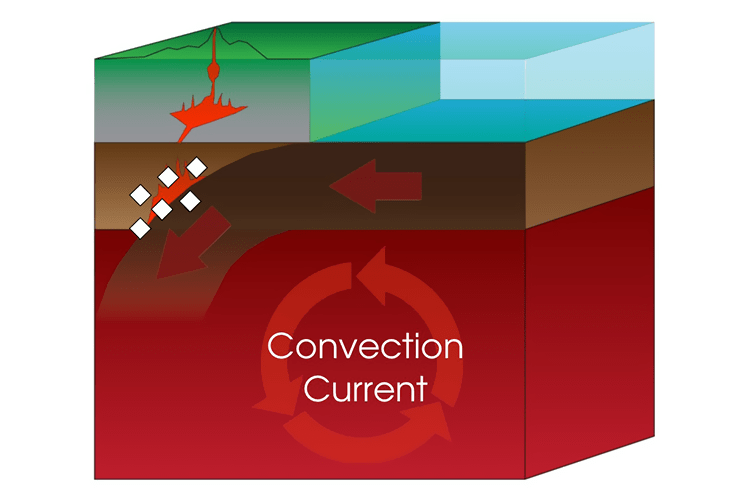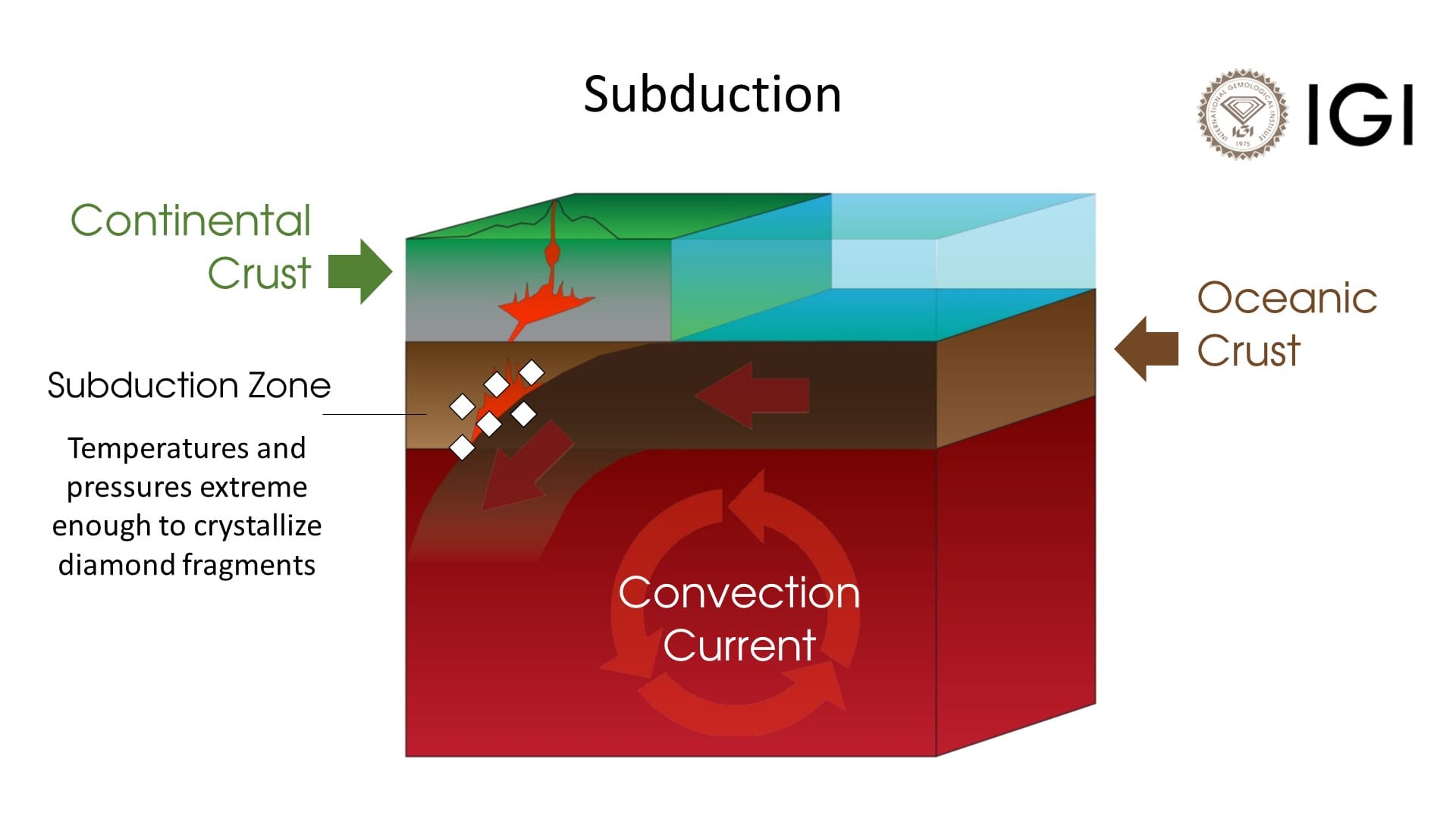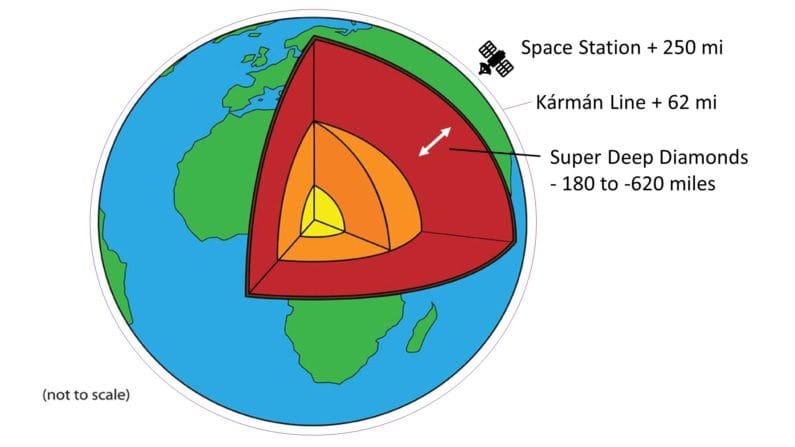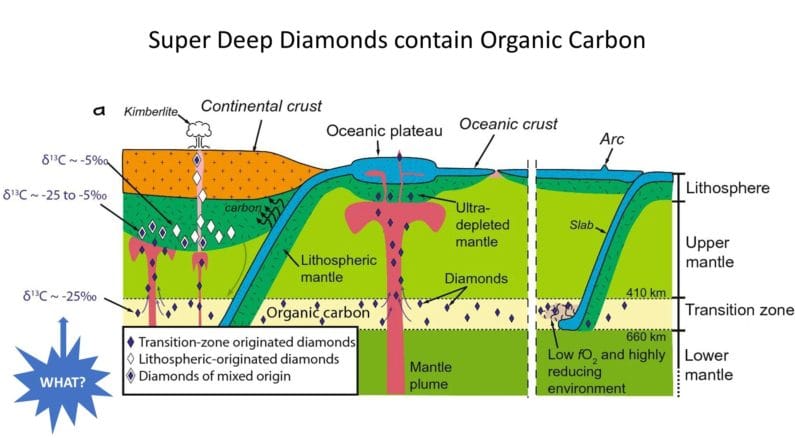Super Deep Diamonds

The Earthly Mystery of ‘Super Deep’ Diamonds
Mother Nature continues to amaze and delight us. Just as mankind seems to have “cracked the code” on the complexities of diamond creation up here, in our laboratories, she smiles and presents more earthly mysteries we have yet to solve.
Diamond Categories
Did you know that diamonds can be categorized according to where they formed in the earth? There are three such categories.
- The main category is Lithospheric Diamonds. They formed in the earth’s lithosphere, around 90-130 miles beneath the surface. This category is by far the most abundant and makes up the vast majority of natural diamonds set into jewelry. If you’re wearing diamonds right now it’s very, very likely they are lithospheric.
- The second category is Oceanic diamonds. These diamonds formed adjacent to regions which, at some point in history, were covered by – you guessed it – the oceans. They’re compelling because of their base carbon makeup.
Let’s dig into that second category a bit more.
Life has existed on earth for 3.7 billion years. One way scientists have confirmed this is studying the makeup of diamonds which formed in crust which was once covered by oceans, as it became subducted. The remains of once-living creatures in oceanic crusts left organic carbon behind. Those diamonds, which formed with a mix of inorganic and organic carbon, have a lighter carbon isotope signature than more common peridotitic diamonds which formed in kimberlites and lamproites.
In scientific terms, common peridotitic diamonds have higher levels of δ13C (delta-C-thirteen) than oceanic diamonds, where the δ13C value drops, due to that lighter organic isotopic signature.
Summarized:
- Common peridotic diamonds = high δ13C.
- Oceanic ‘creature-carbon’ diamonds = low δ13C.

‘Super-Deep Diamonds’
When researchers call something “super” you know it’s going to be cool. Super-Deep Continental Diamonds formed far below the lithosphere, down in a transition zone between the upper and lower mantle, at depths between 180 and 620 miles.
Repeat… -180 to -620 miles
That needs to be put into perspective. Consider that the Kármán Line, the internationally recognized boundary of space, is reached at 62 miles above the earth’s surface. The International Space Station orbits our planet at 250 miles above. Reversing that, Super-Deep Diamonds formed in places so deep that we would classify them as forming in “space” above – some formed in places even deeper than we park our “spaceships” above.
Now that really is SUPER deep. It’s also far less accessible than space; the farthest humans have artificially penetrated the earth is just over –7.6 miles, at a diameter of 9 inches.
Superdeep diamonds can be transported to shallower depths through mantle convection cells, then brought to the surface by kimberlite eruptions, allowing scientists to study them in “depth” and detail (see what I did there?).

Revelation #1
According to an August 2021 study published in Nature.com* , certain Oceanic Diamonds, formed billions of years ago, share the shape and composition of manmade HPHT synthetic diamonds.
Such oceanic diamonds share morphological similarities with synthetic diamonds, e.g., they are euhedral to subhedral with cubo-octahedral shape and low nitrogen aggregation, which led some to question their natural origin.
Fascinating
This is intriguing, in and of itself. These days we tend to associate low to no nitrogen content (aka Type IIa) in gem-quality diamonds with sterile, controlled manmade productions. In particular, Type IIa rough which is cubo-octahedral is associated with the High-Pressure High Temperature (HPHT) lab grown diamond process, which imitates nature. Of course we know Mother Nature produced rare Type IIa specimens in certain cases, but the similarities between Super Deep natural diamonds and modern lab grown diamonds was a new twist.
So twisty, in fact, that it led some career researchers “to question their natural origin.”
Revelation #2
An even more fascinating discovery involves the preconception that Super Deep diamonds formed with inorganic base carbon like the most common peridotitic diamonds which reach the surface.
Upon review (drum-roll…) Super-Deep Diamonds have δ13C values closer to those of Oceanic Diamonds, implying the presence of organic carbon. The fact that these diamonds, from up to 600+ miles deep, formed with base-carbon from previously living things is mind-bending.

Super-surprise!
Wow.
This research provides a basis for better understanding connections between all three categories of diamond – linking them to “mantle plumes, ballooning hot rocks driven by plate tectonics and the supercontinent cycle from deeper earth” – but ultimately acknowledges the presence of recycled organic carbon in Super-Deep diamonds as a super-surprise that needs more study.
Source: International Gemological Institute.
* Doucet, L.S., Li, ZX. & Gamal El Dien, H. Oceanic and super-deep continental diamonds share a transition zone origin and mantle plume transportation. Sci Rep 11, 16958 (2021)